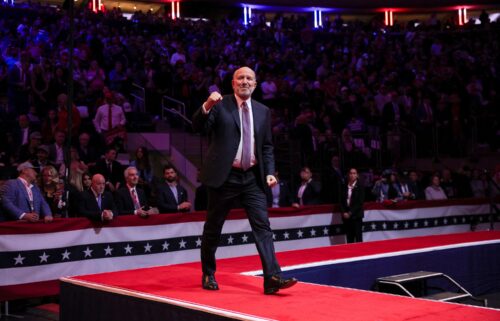Oil is up nearly 70% since the election, a record in the modern era
The oil market is starting the Biden era with a bang. And that means Covid-weary Americans returning to the roads this spring and summer will be greeted with higher prices at the pump.
US oil prices have skyrocketed 69% since November’s election based on Thursday’s close at $63.50 a barrel.
That’s easily the biggest post-election gain through this point in the presidential cycle since NYMEX oil futures began trading in 1983, according to a CNN Business analysis. The next closest post-election rally occurred when crude jumped 31% after President George H.W. Bush’s victory in 1988.
Gasoline prices are also on the rise, climbing 27% since the election, with the national average hitting $2.70 a gallon this week, according to AAA.
The monster gains in the energy market are not about politics or even policy. Rather, they underscore a growing sense that the worst of the deadly pandemic is in the rearview mirror — and the US economy is poised to roar back to life. Wall Street, backed by easy money from the Federal Reserve, is making a massive bet that Americans’ thirst for oil will rise dramatically.
“Higher oil prices are a reflection of optimism about economic growth as the world begins the process of vaccinations to move past the pandemic,” said Jason Bordoff, founding director of Columbia University’s Center on Global Energy Policy.
In recent months, the United States has made major progress in defeating Covid. Both Pfizer and Moderna rolled out highly effective vaccines late last year, and after a sluggish start implementation has accelerated. The country could be just days away from getting access to the first single-shot vaccine.
And as more Americans get vaccinated, they can return to flying, taking road trips and cruises — which in turn will drive up oil demand crushed by the health crisis. Bank of America is predicting it will grow through 2023 at the fastest pace since the 1970s.
The pandemic, combined with a nasty price war between Saudi Arabia and Russia, caused the oil market’s darkest day ever last April. Crude crashed below zero, briefly touching negative $37 a barrel.
The GameStop factor
But just as that selloff was overblown, some fear the price slingshot might be getting out of hand.
“This looks a lot more like a financial rally than a fundamental one,” said Jim Mitchell, head of Americas oil analysts at Refinitiv. He estimated that US oil prices are $7 to $8 higher than where supply-demand dynamics suggest they should be.
Consider that US gasoline demand — the biggest driver for oil prices — hasn’t been this weak in February since 1997.
So why is oil overshooting fundamentals? Easy money on Wall Street is scrounging around for a home. Rock-bottom interest rates from the Fed are encouraging investors to bet on risky assets. Everything from Amazon and GameStop to bitcoin and SPACs are on fire. It only makes sense for oil to join the party — especially because crude is a way to bet on higher inflation.
“We’re riding the money flow higher. But if the money continues to flow in, it becomes a little bit like GameStop,” said Tom Kloza, global head of energy analysis at the Oil Price Information Service.
In other words, the gains may be unsustainable.
For now, Wall Street analysts are betting the rally is just getting started. Goldman Sachs now says US oil prices will average $72 a barrel in the third quarter, up from $62 previously. Some investment banks are even calling for a new “supercycle” that could carry oil to $100.
“It’s very, very premature. It’s like when someone wins a championship in sports and they immediately start talking dynasty,” said Kloza.
The risk of $3 gasoline
The risk is that energy prices rise to levels that slow the recovery by raising costs uncomfortably high for drivers.
“$3-a-gallon gasoline is a number that gets the attention of the public, like 100 wins in baseball,” said Kloza.
Although Kloza doesn’t think the national average will hit $3 a gallon this year, he warned if it does it will cause “irresponsible blame” towards the White House and oil producers.
Others are skeptical that higher energy prices will keep quarantine-fatigued Americans off the roads and planes this summer.
“If you’re stuck at home for a year, you’re probably going to go on that vacation whether oil is at $40 or $90,” said Ryan Fitzmaurice, energy strategist at Rabobank.
In any case, today’s digital economy (less manufacturing, more electric vehicles and remote working) may be able to withstand higher prices than in the past.
“The economy will be far less sensitive to movements in the price of oil than it has been in our lifetimes,” said Joe Brusuelas, chief economist at RSM International. “Many of us are still prisoners of the 1970s oil price shock. But we are several economies away from then.”
OPEC, which was behind the 1970s shock, could soon add more barrels to the world market. The group, along with Russia, could decide next week to ease limits on production starting in April. That could cool off the red-hot market.
Oil’s last dance?
The current oil rally comes at a time when energy policy in Washington is getting an extreme makeover after four years of the fossil fuels-friendly Trump administration.
President Joe Biden has moved swiftly to address the climate crisis by reentering the United States in the Paris Agreement, revoking the Keystone XL pipeline’s permit and ordering a moratorium on new oil and gas leases on federal land and water areas. These steps amount to a shot across the bow of the oil industry and could eventually depress US fossil fuel production.
However, analysts are skeptical that the current rally is directly related to the administration’s oil crackdown. Crude is up by a more modest 20% since Trump’s last day in office.
“Biden’s climate policy has nothing to do with the current rally in oil prices,” said Bordoff, the Columbia professor who served as an energy adviser during the Obama administration.
But the climate crisis and electric vehicles remain real threats to oil.
In a report titled “Oil’s Last Dance,” Bank of America recently predicted EV sales will reach 34% of total car sales by 2030 and overtake gas-guzzling vehicle sales by 2035. The bank expects global oil demand to peak around 2030.


